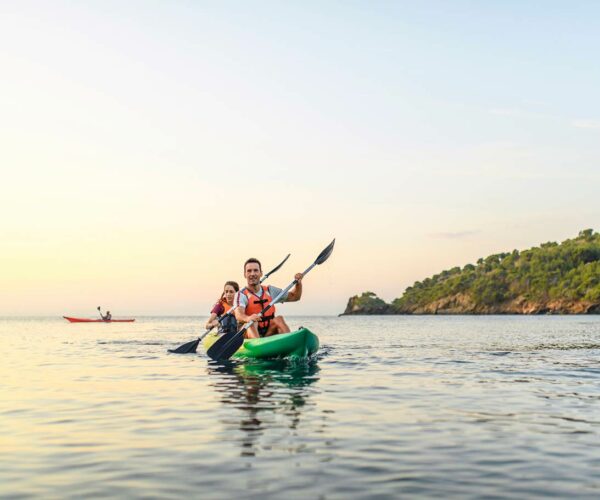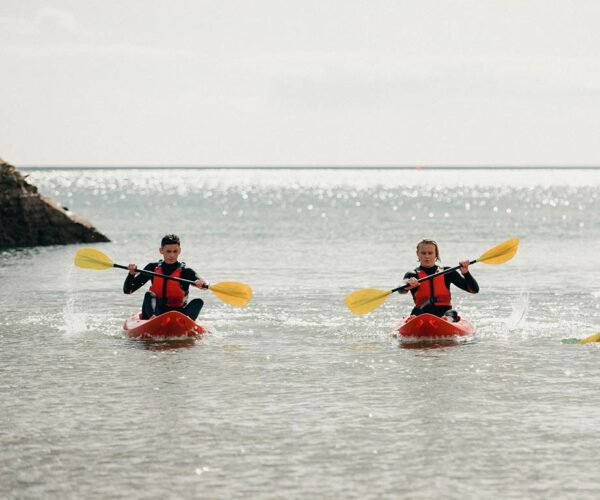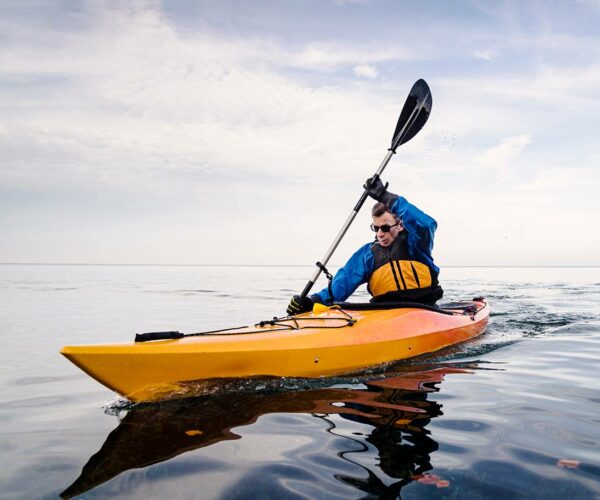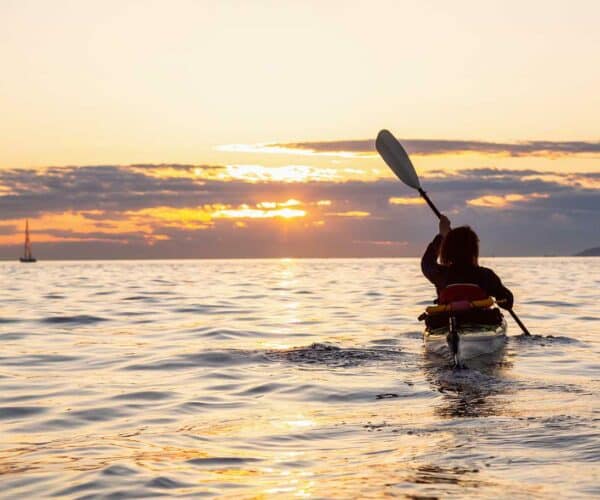If you’re someone who loves outdoor sports and is itching to try something new on the water, sea kayaking offers an exhilarating experience like no other. Picture yourself gliding along in clear blue waters, with breathtaking coastal views all around you and friendly marine critters popping up here and there.
Whether you’re eyeing the wild shores of the UK or dreaming of far-off tropical waters, sea kayaking is all about discovering new thrills and sights. In this blog, we’ll cover everything you need to kickstart your sea kayaking journey, from handy prep tips to keeping safe while you paddle. So, grab your paddle and let’s explore the intrepid world of sea kayaking for beginners!
Preparing for Your First Sea Kayaking Adventure

Gear Essentials
Kayak and Paddle
Selecting the right kayak and paddle is crucial for efficient and enjoyable paddling. Kayaks come in various designs suited for different types of water and paddling styles, so choosing one that matches your intended use and skill level will help with your capabilities. Other consideration includes the appropriate paddle in terms of length, material, and blade shape can significantly impact performance and reduce fatigue.
Clothing
Proper clothing and sun protection are sensible for staying comfortable and safe during long hours on the water. Quick-drying clothing, such as moisture-wicking base layers and waterproof outer layers, help regulate body temperature and provide protection from wind and water. Additionally, wearing a wide-brimmed hat, sunglasses with UV protection, and applying sunscreen to exposed skin are crucial for safeguarding against sunburn and UV damage.
Safety Gear
A safety equipment checklist is indispensable for preparedness in case of emergencies. This includes essentials such as a Personal Flotation Device (PFD), a whistle or signalling device, a bilge pump or sponge for bailing water, a first aid kit, and navigation tools such as a map and compass or GPS device. By ensuring you have the right gear before setting out on your sea kayaking adventure, you can enhance safety and peace of mind while exploring the waterways.
Skill Building

Paddling Techniques
Firstly, mastering basic paddling techniques lays the foundation for efficient and controlled movement through the water. This includes learning proper hand positioning, torso rotation, and paddle strokes such as forward, reverse, and sweep strokes.
Practice sessions
Practice sessions in calm waters provide an ideal environment for beginners to hone their skills and build confidence without the added challenge of strong currents or rough conditions. These sessions allow paddlers to focus on refining their technique and familiarising themselves with the feel of the kayak and paddle.
Rescue and Self-Recovery
Learning rescue and self-recovery skills is fundamental for handling unexpected situations on the water. Practicing techniques such as assisted and self-rescue drills, including re-entering the kayak from the water and performing a T-rescue with a partner, equips paddlers with the knowledge and ability to stay safe and recover from capsizes or other emergencies.
By dedicating time to skill building through practice and training, beginner sea kayakers can develop the proficiency and preparedness needed for enjoyable and safe adventures on the water.
Planning Your Trip
Planning your trip is a crucial step for beginner sea kayakers to ensure a safe and enjoyable experience on the water. Researching your route and location can help obtain a better understanding of the challenges and attractions of the area you plan to explore.
Consider factors such as water conditions, currents, navigation hazards, and points of interest along your route. Checking weather and tide forecasts is imperative for anticipating changing conditions and planning your paddling schedule accordingly. High winds, rough seas, or strong tidal currents can significantly impact your safety and comfort on the water, so staying informed about upcoming weather patterns is advised.
Share your planned route, estimated time of departure and return, and emergency contact information with a trusted friend or family member. This ensures that someone knows your whereabouts and can alert authorities in case of an unexpected delay or emergency.
Copenhagen, Denmark
Ironman Copenhagen offers a unique urban racing experience in the heart of Denmark’s capital city. Athletes swim in the clean and calm waters of Copenhagen Harbor, with panoramic views of the city skyline. The bike course winds through the picturesque countryside and charming coastal villages, while the run takes participants on a tour of Copenhagen’s historic landmarks and scenic waterfront.
Sea Kayaking Safety Tips

Paddling techniques for stability
Adjusting your paddling techniques for stability is beneficial for beginner sea kayakers. It helps maintain control and confidence on the water, minimising the risk of capsizing or losing balance.
Keep a low centre of gravity is key to enhancing stability in the kayak. By positioning your body low in the kayak and distributing your weight evenly, you create a stable base that helps to counteract the effects of waves and currents. This involves bending your knees slightly and keeping your torso centered over the kayak, avoiding leaning too far to either side.
Another factor for stability is to maintain a proper posture. Sit upright with your back straight and shoulders relaxed, engaging your core muscles to provide support and stability. Avoid slouching or leaning too far forward or backward, as this can compromise your balance and control.
Awareness of Surroundings
Awareness of surroundings is paramount for beginner sea kayakers to ensure a safe and enjoyable paddling experience.
Weather Conditions
Monitoring weather changes is necessary for anticipating and responding to shifting conditions that could impact safety. Keep an eye on the sky for signs of approaching storms, changes in wind direction or speed, and fluctuations in temperature. Sudden weather changes can affect water conditions and pose risks such as strong winds, rough waves, or lightning strikes.
Watching for Obstacles
Watching for water traffic and obstacles helps prevent collisions and navigational challenges. Be vigilant for other vessels, including boats, ferries, and recreational watercraft, and yield the right of way when necessary. Additionally, scan the water surface for potential hazards such as rocks, logs, or floating debris that could pose a threat to navigation or cause damage to your kayak. By staying alert and responsive to their surroundings, beginner sea kayakers can enhance safety and confidence while exploring the waterways.
Understanding the Difficulty Level of Sea Kayaking
Understanding the difficulty level of sea kayaking is crucial for beginners embarking on this exhilarating water sport. Beyond the serene beauty of coastal landscapes lies a realm that presents both physical and mental challenges. Paddling against currents, navigating through choppy waters, and maintaining balance in varying conditions demand physical stamina and strength.
Additionally, the mental aspect involves quick decision-making, assessing risks, and adapting to changing environments. It’s paramount for beginners to start slow, focusing on building fundamental skills and gradually increasing the complexity of their paddling excursions. Rome wasn’t built in a day, and mastering sea kayaking takes time, persistence, and patience.
Encouraging novices to embrace a learning mindset, celebrate small victories, and learn from setbacks fosters growth and confidence on the water.
Communication and Buddy System
Effective communication and the buddy system are indispensable for ensuring safety during beginner sea kayaking adventures. By prioritising communication and the buddy system, beginner sea kayakers can navigate safely and confidently, knowing that support and assistance are readily available when needed.
Hand Signals
Using hand signals and verbal cues allows paddlers to convey important information and coordinate actions while on the water. Establishing a set of clear and universally understood signals enables kayakers to communicate essential messages such as “stop,” “go,” or “help.”
Verbal cues
Verbal cues can be used to relay more detailed information or coordinate manoeuvres. Staying within sight of others in your group is equally important, as it enables quick assistance in case of emergencies and fosters a sense of security.
Visual Contact
Maintaining visual contact with your paddling companions ensures that you can respond promptly to any unexpected situations or changes in conditions.
Mistakes to Avoid When Sea Kayaking

Lack of Proper Preparation
Lack of proper preparation can swiftly turn a promising sea kayaking adventure into risky business. Underestimating the importance of gear can leave kayakers vulnerable to the elements. Essential items such as a well-fitted PFD, a reliable kayak, and appropriate clothing for weather conditions are crucial for safety and comfort on the water.
Neglecting to check weather and tide conditions can lead to unexpected challenges and dangers. Seemingly calm waters can quickly transform into treacherous conditions with changing weather patterns or tidal currents. It’s good planning for kayakers to research and understand the forecasted conditions, as well as how they might impact their planned route and overall safety.
Poor Paddling Technique
Poor paddling technique is a common pitfall for many novice sea kayakers, often resulting in fatigue, inefficiency, and even potential injury. Gripping the paddle incorrectly is a frequent mistake, as improper hand placement can diminish control and power. It’s crucial for paddlers to maintain a loose grip, with hands comfortably spaced and thumbs pointing towards the water.
Relying too heavily on arm strength rather than engaging the core muscles is another prevalent error. Effective paddling stems from using the large muscles in the torso, such as the abdominals and back, to generate power and maintain stability.
Ignoring Safety Guidelines
Ignoring safety guidelines while sea kayaking can significantly increase the risk of accidents and mishaps on the water. Adhering to safety guidelines, including wearing a PFD and respecting personal limits, is paramount for a safe and enjoyable sea kayaking experience.
Safety Equipment
Failing to wear a Personal Flotation Device (PFD) is a grave error that can have dire consequences. A PFD is a vital piece of safety equipment that can save lives by providing buoyancy and keeping kayakers afloat in the event of a capsize or emergency.
Underestimating Ability
Venturing beyond one’s skill level or ignoring personal limits is another common mistake that can lead to dangerous situations. It’s crucial for kayakers to accurately assess their abilities and choose routes and conditions that align with their skill level. Ignoring these limits can result in fatigue, panic, or being unable to handle unexpected challenges, putting both the kayaker and their companions at risk.
Overlooking Environmental Awareness
Approaching wildlife too closely or disturbing nesting areas can cause undue stress and harm to animals, impacting their behaviour and survival. Furthermore, neglecting to properly dispose of waste, disturbing vegetation, or leaving behind litter can pollute waterways and harm wildlife. Kayakers should adhere to the ‘Leave No Trace’ principles.
Plan ahead and prepare
Travel and camp on durable surfaces
Dispose of waste properly
Leave what you find
Minimise campfire impact
Respect wildlife
Be considerate of other visitors
Failing to have proper insurance
Many people forget to get insurance when taking part in activities in the UK. Furthermore, some travel insurance does not include certain activities in a standard policy, but this is not always clear. Make sure you check that you have suitable insurance for sea kayaking before you get started. It could mean you avoid being out of pocket if things go wrong.
Get Sea Kayaking Insurance with SportsCover Direct
Time to get yourself properly prepared and make that sea kayaking trip happen! Whether you’re experienced at kayaking or not, it is aways worth preparing yourself for possible eventualities. Whilst taking risks is all part of the thrill of embarking on a new sport such as sea kayaking, it’s not advised to throw caution to the wind. When things go wrong you can be faced with costly expenses to put things right. Before you go, spend a moment getting the right insurance and then you can focus on having the time of your life with the appropriate protection.
SportsCover Direct’s Sea Kayaking Insurance offers worldwide protection, with cover for yourself and your sea kayaking equipment. Our travel insurance covers you while abroad, whether you’re kayaking for leisure or a competition. This incorporates cover for medical costs, trip cancellation, and more. If you already have an insurance policy, opt for our bolt-on style of protection. You can also go for sports accident insurance, created to protect you while kayaking in the UK.
Find out more and get an instant quote online.
This blog has been created as general information and should not be taken as advice. Make sure you have the correct level of insurance for your requirements and always review policy documentation.